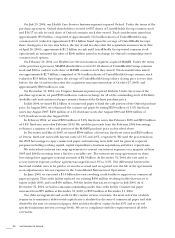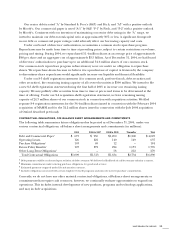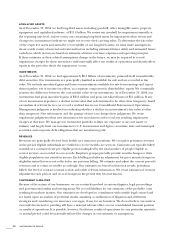United Healthcare 2004 Annual Report Download - page 38
Download and view the complete annual report
Please find page 38 of the 2004 United Healthcare annual report below. You can navigate through the pages in the report by either clicking on the pages listed below, or by using the keyword search tool below to find specific information within the annual report.
36 UNITEDHEALTH GROUP
LONG-LIVED ASSETS
As of December 31, 2004, we had long-lived assets, including goodwill, other intangible assets, property,
equipment and capitalized software, of $11.8 billion. We review our goodwill for impairment annually at
the reporting unit level, and we review our remaining long-lived assets for impairment when events and
changes in circumstances indicate we might not recover their carrying value. To determine the fair value
of the respective assets and assess the recoverability of our long-lived assets, we must make assumptions
about a wide variety of internal and external factors including estimated future utility and estimated future
cash flows, which in turn are based on estimates of future revenues, expenses and operating margins.
If these estimates or their related assumptions change in the future, we may be required to record
impairment charges for these assets that could materially affect our results of operations and shareholders’
equity in the period in which the impairment occurs.
INVESTMENTS
As of December 31, 2004, we had approximately $8.3 billion of investments, primarily held in marketable
debt securities. Our investments are principally classified as available for sale and are recorded at fair
value. We exclude unrealized gains and losses on investments available for sale from earnings and report
them together, net of income tax effects, as a separate component in shareholders’ equity. We continually
monitor the difference between the cost and fair value of our investments. As of December 31, 2004, our
investments had gross unrealized gains of $215 million and gross unrealized losses of $11 million. If any
of our investments experience a decline in fair value that is determined to be other than temporary, based
on analysis of relevant factors, we record a realized loss in our Consolidated Statements of Operations.
Management judgment is involved in evaluating whether a decline in an investment’s fair value is other
than temporary. New information and the passage of time can change these judgments. We revise
impairment judgments when new information becomes known and record any resulting impairment
charges at that time. We manage our investment portfolio to limit our exposure to any one issuer or
industry and largely limit our investments to U.S. Government and Agency securities, state and municipal
securities, and corporate debt obligations that are investment grade.
REVENUES
Revenues are principally derived from health care insurance premiums. We recognize premium revenues
in the period eligible individuals are entitled to receive health care services. Customers are typically billed
monthly at a contracted rate per eligible person multiplied by the total number of people eligible to
receive services, as recorded in our records. Employer groups generally provide us with changes to their
eligible population one month in arrears. Each billing includes an adjustment for prior month changes in
eligibility status that were not reflected in our previous billing. We estimate and adjust the current period’s
revenues and accounts receivable accordingly. Our estimates are based on historical trends, premiums
billed, the level of contract renewal activity and other relevant information. We revise estimates of revenue
adjustments each period, and record changes in the period they become known.
CONTINGENT LIABILITIES
Because of the nature of our businesses, we are routinely involved in various disputes, legal proceedings
and governmental audits and investigations. We record liabilities for our estimates of the probable costs
resulting from these matters. Our estimates are developed in consultation with outside legal counsel and
are based upon an analysis of potential results, assuming a combination of litigation and settlement
strategies and considering our insurance coverages, if any, for such matters. We do not believe any matters
currently threatened or pending will have a material adverse effect on our consolidated financial position
or results of operations. It is possible, however, that future results of operations for any particular quarterly
or annual period could be materially affected by changes in our estimates or assumptions.
























